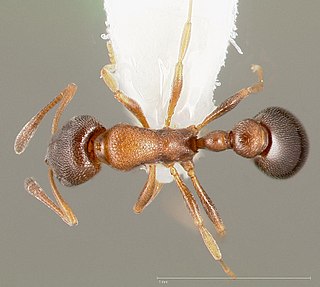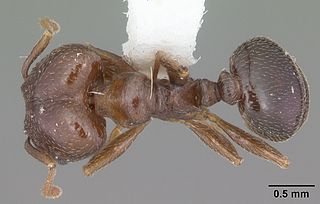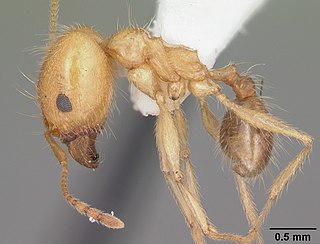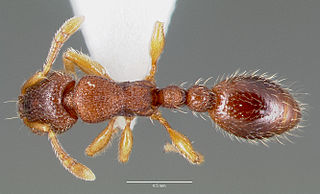
Odontomachus relictus is a species of trapjaw ant in the subfamily Ponerinae native to Florida.

Cardiocondyla mauritanica is a species of Myrmicine ant. It is native to North Africa and the Middle East, but has since become a widespread tramp species and are now found virtually worldwide.

Pheidole vistana is a species of ant and a higher myrmicine in the family Formicidae.

Pheidole moerens is an ant, a species of higher myrmicine in the family Formicidae.

Pheidole rhea is a species of ant and a higher myrmicine in the family Formicidae.

Brachymyrmex patagonicus, also known as the black rover ant, is a species of Formicine ant native to Mexico, Central America, South America, and invasive in the United States and Europe. They were first reported in St. Tammany Parish, Louisiana in 1978 from a single colony collected in 1976. It is believed that the species was introduced through New Orleans, which is a common entry point for many tropical species, but other locations such as Mobile, Alabama, or Pensacola, Florida, are also likely. For many years B. patagonicus, B. musculus, and B. obscurior were misidentified as being separate species but after a comparison of specimens from the Louisiana State University Arthropod Collection (LSUC), it was found that all three were the same species. B. patagonicus is considered a nuisance pest due to their tendency to infest man-made structures but have received a lack of attention because they do not bite, sting, or carry disease.

Pheidole tysoni is a species of ant and a higher myrmicine in the family Formicidae.

Hypoponera punctatissima, or Roger's ant, is a species of Ponerine ant native to Africa but now found worldwide as a tramp species.

Camponotus vicinus is a species of carpenter ant widespread throughout western North America; it is found from Alaska, south to Mexico, and east to Texas and Manitoba. Unlike its wood-nesting relatives, C. vicinus is typically found nesting in the soil under stones and other objects.

Pheidole xerophila is a species of ant and a higher myrmicine in the family Formicidae.

Pheidole californica is an ant, a species of higher myrmicine in the family Formicidae.

Pheidole obtusospinosa is a species of ant and a higher myrmicine in the family Formicidae.

Pheidole pilifera is a species of ant and a higher myrmicine in the family Formicidae.

Xenomyrmex floridanus is a species of ant in the family Formicidae.

Camponotus chromaiodes, known generally as, the ferruginous carpenter ant or red carpenter ant, is a species of carpenter ant native to the eastern United States, Nebraska, Kansas, and possibly California. Acetobacteraceae are found in the guts of workers in this species.

Pheidole crassicornis is an ant, a species of higher myrmicine in the family Formicidae.

Aphaenogaster fulva is a species of ant in the family Formicidae.

Pheidole morrisii is a species of ant and a higher myrmicine in the family Formicidae.

Pheidole dentigula is an ant, a species of higher myrmicine in the family Formicidae.

Vollenhovia emeryi is a species of ant in the family Formicidae.





















